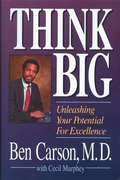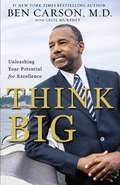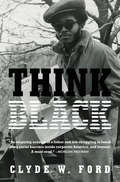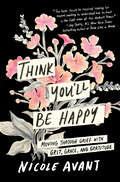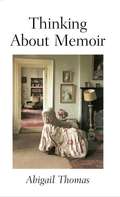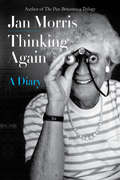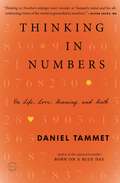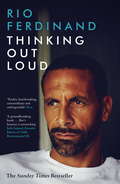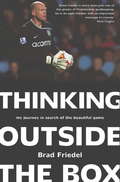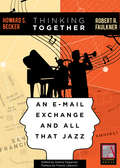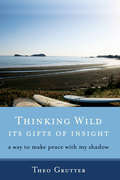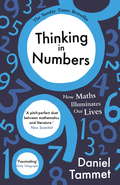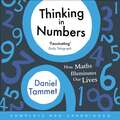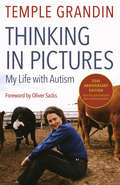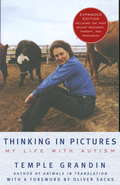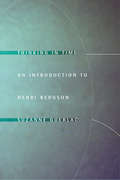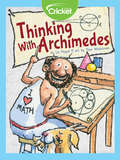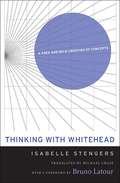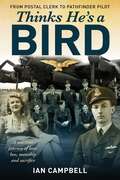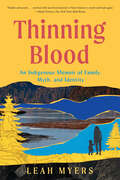- Table View
- List View
Think Big: Overcoming Obstacles with Optimism
by Jennifer Arnold Bill KleinBestselling authors of Life is Short (No Pun Intended) and stars of TLC's The Little Couple return with an inspirational book that encourages readers to reach for their dreams, no matter what obstacles they may face.Jennifer Arnold and Bill Klein have faced some big challenges in their lives. On the way to becoming a preeminent neonatologist and a successful entrepreneur--as well as parents and television stars--these two have faced prejudice, medical scares, and the uncertainty of life with special needs children. And even though they have dealt with fear, depression, hopelessness, and the urge to give up, they have found a way to persevere. Now they share their wisdom and encouragement for everyone who is facing their own challenges. Drawn from their most popular speaking presentation, Think Big is the inspirational guide for dreaming big, setting goals, and the steps you need to take to get there. Each section includes heartwarming anecdotes full of grace, humor, and wit plus a never-before-seen look inside their personal and professional lives. They have plenty of stories to tell and their unique approach to encountering life's greatest difficulties will inspire a call to action in all of us.
Think Big: Unleashing Your Potential for Excellence
by Ben CarsonConduct life with reference to God and your own talents.
Think Big: Unleashing Your Potential for Excellence
by Ben Carson Cecil MurpheyIn Think Big, which emanates from the last chapter of his best-selling Gifted Hands, Dr. Ben Carson prescribes his personal formula for success. And who could better advise than one who transformed his own life from that of being a ghetto kid with problems in school to becoming the most celebrated pediatric neurosurgeon in the world? With an acrostic, Dr. Carson spells out his philosophy of living: T -Talents/time: Recognize as gifts from God H -Hope for good things and be honest I -insight from people and good books N -Be nice to all people K -Knowledge: Recognize as they key to living B -Books: Read them actively I -In-depth learning skills: Develop them G -God: Never get too big for Him -- Think Big does not offer pat answers, or promise a life of ease, but it does show how a person should view problems, evaluate them, react to them, and eventually overcome them. The philosophy in Think Big can be applied by all individuals to their own lives and help them to make the most of the gifts that God has given them.
Think Black: A Memoir
by Clyde W. Ford“Powerful memoir. . .Ford’s thought-provoking narrative tells the story of African-American pride and perseverance.” –Publisher’s Weekly (Starred)“A masterful storyteller, Ford interweaves his personal story with the backdrop of the social movements unfolding at that time, providing a revealing insider’s view of the tech industry. . . simultaneously informative and entertaining. . . A powerful, engrossing look at race and technology.”–Kirkus Review (Starred)In this thought-provoking and heartbreaking memoir, an award-winning writer tells the story of his father, John Stanley Ford, the first black software engineer at IBM, revealing how racism insidiously affected his father’s view of himself and their relationship.In 1947, Thomas J. Watson set out to find the best and brightest minds for IBM. At City College he met young accounting student John Stanley Ford and hired him to become IBM’s first black software engineer. But not all of the company’s white employees refused to accept a black colleague and did everything in their power to humiliate, subvert, and undermine Ford.Yet Ford would not quit. Viewing the job as the opportunity of a lifetime, he comported himself with dignity and professionalism, and relied on his community and his "street smarts" to succeed. He did not know that his hiring was meant to distract from IBM’s dubious business practices, including its involvement in the Holocaust, eugenics, and apartheid.While Ford remained at IBM, it came at great emotional cost to himself and his family, especially his son Clyde. Overlooked for promotions he deserved, the embittered Ford began blaming his fate on his skin color and the notion that darker-skinned people like him were less intelligent and less capable—beliefs that painfully divided him and Clyde, who followed him to IBM two decades later.From his first day of work—with his wide-lapelled suit, bright red turtleneck, and huge afro—Clyde made clear he was different. Only IBM hadn’t changed. As he, too, experienced the same institutional racism, Clyde began to better understand the subtle yet daring ways his father had fought back.
Think You'll Be Happy: Moving Through Grief with Grit, Grace, and Gratitude
by Nicole AvantThink You'll Be Happy has descriptive copy which is not yet available from the Publisher.
Think! Eat! Act!: A Sea Shepherd Chef's Vegan Recipes (Vegan Cookbooks Ser.)
by Raffaella TolicettiThink!, Eat!, Act! is a cookbook featuring the vegan food prepared on the Sea Shepherd ships' anti-whaling campaigns. Inspired by the Sea Shepherd's goal of protecting the animals that are victims of human cruelty, this book uses delicious vegan food to show readers that every action has a consequence, and that you can live both well and compassionately, even while facing the challenges of being an activist living on a ship.
Thinking About Memoir
by Abigail ThomasIf living is an art, it must be practiced with diligence before being done with ease. Yet almost nothing in our culture prepares us for reflection on the great themes of existence: courage, friendship, listening, dignity--those everyday virtues that can transform our world. Because AARP believes it's never too late (or too early) to learn, they, together with Sterling Publishing, have created theAbout Livingseries to address these crucial issues. Each entry will be written by only the best authors and thinkers. Thinking About Memoir, the first of these volumes, helps adults look back at their past and use writing as a means of figuring out who they used to be and how they became who they are today. It's written by Abigail Thomas, whose own memoirA Three Dog Lifewas selected as one of the Best Books of 2006 by the LA Times and the Washington Post and called "perfectly honed" (Newsweek), "bracingly honest" (Vanity Fair), and "stunning" by theLos Angeles Book Review. Thomas writes that memoir can consist of looking back at a single summer or the span of a whole life. Through her experience as a writing teacher, she knows how difficult that can be; this book is about the habit of writing as a way to keep track of what's going on in the front and the back of your mind. It inspires different ways for us to look at the moment we're in right now and will help would-be memoirists find their own "side door" into a subject. Thomas writes eloquently about how to get started and find that jumping-off point for your work, and provides exercises that liberate our creativity, enable us to get the distance and perspective we need, and open our eyes to possibilities that may not at first seem obvious. Whether your words are for publication, for your loved ones, or for you alone, Thomas makes the process fulfilling, thoughtful, and even fun.
Thinking Again: A Diary
by Jan MorrisJan Morris, one of “Britain’s greatest living writers” (Times, UK), returns with this whimsical yet deeply affecting volume on life as a redoubtable nonagenarian. The irrepressible Jan Morris—author of such classics as Venice and Trieste—is at it again: offering a vibrant set of reminiscences that remind us “what a good, wise and witty companion Jan Morris has been for so many readers for so long” (Alexander McCall Smith, New York Times Book Review). “Like Michel de Montaigne” (Danny Heitman, Wall Street Journal), Morris waxes on the ironies of modern life in all their resonant glories and inevitable stupidities—from her daily exercise (a “statutory thousand paces of brisk walk”) to the troubles of Brexit; her enduring yet complicated love for America; and honest reflections on the vagaries and ailments of aging. Both intimate and luminously wise, Thinking Again is a testament to the virtues of embracing life, creativity, and, above all, kindness.
Thinking In Numbers: On Life, Love, Meaning, and Math
by Daniel Tammet"Englarges one's wonder at Tammet's mind and his all-embracing vision of the world as grounded in numbers." --Oliver Sacks, MD THINKING IN NUMBERS is the book that Daniel Tammet, bestselling author and mathematical savant, was born to write. In Tammet's world, numbers are beautiful and mathematics illuminates our lives and minds. Using anecdotes, everyday examples, and ruminations on history, literature, and more, Tammet allows us to share his unique insights and delight in the way numbers, fractions, and equations underpin all our lives. Inspired by the complexity of snowflakes, Anne Boleyn's eleven fingers, or his many siblings, Tammet explores questions such as why time seems to speed up as we age, whether there is such a thing as an average person, and how we can make sense of those we love. THINKING IN NUMBERS will change the way you think about math and fire your imagination to see the world with fresh eyes.
Thinking Out Loud: Love, Grief and Being Mum and Dad
by Rio FerdinandTHE SUNDAY TIMES TOP TEN BESTSELLER'A lacerating account ... painful but necessary' EVENING STANDARD'Beautiful & significant ... Tackles grief with honesty' DAWN FRENCH'Very important and moving book' ALASTAIR CAMPBELL'A searingly honest book. So much of Rio's emotional turmoil and deep loss resonated with me. At the same time I loved his message of hope' GLORIA HUNNIFORD'Rio's courageous story of life, loss, grief and hope' PRIMA CHRISTMAS GIFT GUIDE, 'Best of the Celebrity Crop''Tender, heartbreaking ... An extraordinary and unforgettable book. *****' HEAT* * * * * *'When Rebecca died, the idea that one day I might begin to feel better would have struck me as laughable ... I know how persuasive this kind of permanence thinking can be. I know too that anyone locked in its grip will laugh if I promise them that their pain will one day ease. It will. Of course it will. But I know better than to expect anyone to believe me.'In 2015, former England football star Rio Ferdinand suddenly and tragically lost his wife and soulmate Rebecca, aged 34, to cancer. It was a profound shock and Rio found himself struggling to cope not just with the pain of his grief, but also with his new role as both mum and dad to their three young children. Rio's BBC1 documentary, Being Mum and Dad, touched everyone who watched it and won huge praise for the honesty and bravery he showed in talking about his emotions and experiences. His book now shares the story of meeting, marrying and losing Rebecca, his own and the family's grief - as well as the advice and support that get him through each day as they strive to piece themselves back together. Thinking Out Loud is written in the hope that he can inspire others struggling with loss and grief to find the help they need through this most difficult of times.
Thinking Out Loud: Love, Grief and Being Mum and Dad
by Rio FerdinandTHE SUNDAY TIMES TOP TEN BESTSELLER'A lacerating account ... painful but necessary' EVENING STANDARD'Beautiful & significant ... Tackles grief with honesty' DAWN FRENCH'Very important and moving book' ALASTAIR CAMPBELL'A searingly honest book. So much of Rio's emotional turmoil and deep loss resonated with me. At the same time I loved his message of hope' GLORIA HUNNIFORD'Rio's courageous story of life, loss, grief and hope' PRIMA CHRISTMAS GIFT GUIDE, 'Best of the Celebrity Crop''Tender, heartbreaking ... An extraordinary and unforgettable book. *****' HEAT* * * * * *'When Rebecca died, the idea that one day I might begin to feel better would have struck me as laughable ... I know how persuasive this kind of permanence thinking can be. I know too that anyone locked in its grip will laugh if I promise them that their pain will one day ease. It will. Of course it will. But I know better than to expect anyone to believe me.'In 2015, former England football star Rio Ferdinand suddenly and tragically lost his wife and soulmate Rebecca, aged 34, to cancer. It was a profound shock and Rio found himself struggling to cope not just with the pain of his grief, but also with his new role as both mum and dad to their three young children. Rio's BBC1 documentary, Being Mum and Dad, touched everyone who watched it and won huge praise for the honesty and bravery he showed in talking about his emotions and experiences. His book now shares the story of meeting, marrying and losing Rebecca, his own and the family's grief - as well as the advice and support that get him through each day as they strive to piece themselves back together. Thinking Out Loud is written in the hope that he can inspire others struggling with loss and grief to find the help they need through this most difficult of times.
Thinking Out Loud: Love, Grief and Being Mum and Dad
by Rio Ferdinand'Nothing can ever ease the pain of the death of someone you love, nothing can magic it away. But if I can help anyone else facing what we have gone through, of what we're still going through, by sharing what I've learnt, our loss won't feel completely meaningless.'The courageous and moving story of former England and Manchester United footballer Rio Ferdinand's sudden and tragic loss of his wife Rebecca to cancer. Written to help others through their grief, he shares, openly and honestly, the hard journey he's on with his three young children and the support and advice that's getting them through.In 2015, former England football star Rio Ferdinand suddenly and tragically lost his wife and soulmate Rebecca, aged 34, to cancer. It was a profound shock and Rio found himself struggling to cope not just with the pain of his grief, but also with his new role as both mum and dad to their three young children. Rio's BBC1 documentary, Being Mum and Dad, touched everyone who watched it and won huge praise for the honesty and bravery he showed in talking about his emotions and experiences. His book now shares the story of meeting, marrying and losing Rebecca, his own and the family's grief - as well as the advice and support that get him through each day as they strive to piece themselves back together. It is written in the hope that he can inspire others struggling with loss and grief to find the help they need through this most difficult of times.(P)2017 Hodder & Stoughton Limited
Thinking Outside the Box: My Journey in Search of the Beautiful Game
by Brad FriedelGoalkeepers have an unusual view of the world, but Brad Friedel's is more unusual than most. An American, a university graduate, a visionary and a deep thinker, he spurns football culture to concentrate on his game and develop his ideas.One of the most highly-rated - and experienced - goalkeepers in the country, Friedel endured a five-year battle to play in the Premier League. His incredible journey took him from three World Cup tournaments, spells with foreign clubs, and finally to the top flight at Blackburn Rovers and Aston Villa.Friedel's inspirational story provides true perspective and takes us outside the box and inside the world of professional football in a way only he can.
Thinking Outside the Box: My Journey in Search of the Beautiful Game
by Brad Friedel'To be able to work well in the box, I believe you have to be able to think "outside the box"' - a fascinating insider account of the Premier League and life at the top level of football from one of the country's best-rated goalkeepers.Goalkeepers have an unusual view of the world, but Brad Friedel's is more unusual than most. An American, a university graduate, a visionary and a deep thinker, he spurns football culture to concentrate on his game and develop his ideas.One of the most highly-rated - and experienced - goalkeepers in the country, Friedel endured a five-year battle to play in the Premier League. His incredible journey took him from three World Cup tournaments, spells with foreign clubs, and finally to the top flight at Blackburn Rovers and Aston Villa.Friedel's inspirational story provides true perspective and takes us outside the box and inside the world of professional football in a way only he can.
Thinking Together: An E-Mail Exchange and All That Jazz
by Howard S. Becker Robert R. Faulkner Larry Gross Arlene Luck Franck Leibovici Dianne HagamanFaulkner and Becker, sociologists and experienced musicians, wrote a book about their musical experiences--Do You Know? The Jazz Repertoire in Action--describing how musicians who didn't know each other could perform competently and interestingly without rehearsing, or playing from written music. When they wrote it, they lived at opposite ends of the country: Faulkner in Massachusetts, Becker in San Francisco. Instead of sitting around talking about their ideas, they wrote e-mails. So every step of their thinking, false steps as well as ideas that worked, existed in written form.When conceptual artist and poet Franck Leibovici asked them to contribute something that showed the "form of life" that supported their work, they collaborated with Dianne Hagaman to put the correspondence in order, which Liebovici exhibited and now appears as an e-book (which allows linking to available performances of the tunes they discussed).It's one of the most revealing records of a scientific collaboration ever made public, and an intimate picture of the creative process.Collective creativity--making sparks of originality produce something more than a glint in someone's eye--intrigues sociologists, people who study communication and theorists of business organization. The collective part of that process, turning an idea into a finished product, is even more complicated, and Thinking Together readers can watch the authors go through all the complications of working together to make the final result happen.Becker played piano in Chicago and Kansas City and taught sociology at Northwestern University. Among his books are Art Worlds and Writing for Social Scientists.Faulkner played trumpet in Los Angeles, got a PhD in sociology from UCLA, then taught at the University of Rochester and the University of Massachusetts (playing professionally in those places too). He is author of two books about the movie business, Hollywood Studio Musicians and Music on Demand: Composers and Careers in the Hollywood Film Industry.
Thinking Wild: Its Gifts of Insight - A Way to Make Peace with My Shadow
by Theo GrutterTheo Grutter is a big, friendly bear of an unpretentious, spontaneous outdoorsman. Born and educated mostly in Switzerland to enter the corporate world, he soon discovered that this life wasn't for him. He moved to Paris and married Clara, a concert pianist. They landed in New York to search for a lifestyle more to their liking in which to raise a family, which soon grew to include five children. They lived in many places, finally settling in a small Mexican Pacific coast fishing village in winter and traveling up to Sitka, Alaska in the summers, where Theo still fishes as a solitary commercial fisherman. Theo and Clara took yearly walkabouts in many exotic countries of the world, with Theo ever observing, learning, and writing about how life works on Earth. Thinking Wild is the fruit of twelve years' work, a series of essays carved in Theo's non-native and poetic English, written by a remarkable man with deep insight, a fisher philosopher, a seer and seeker railing against man's disrespect of other lifeforms on Earth. All is shared by a man who sees his life as his work of art, and treads a path towards a new way of seeing life more lovingly.
Thinking in Numbers: How Maths Illuminates Our Lives
by Daniel TammetThis is the book that Daniel Tammet, bestselling author and mathematical savant, was born to write. In Tammet's world, numbers are beautiful and mathematics illuminates our lives and minds. Using anecdotes and everyday examples, Tammet allows us to share his unique insights and delight in the way numbers, fractions and equations underpin all our lives.Inspired by the complexity of snowflakes, Anne Boleyn's sixth finger or his mother's unpredictable behaviour, Tammet explores questions such as why time seems to speed up as we age, whether there is such a thing as an average person and how we can make sense of those we love.Thinking in Numbers will change the way you think about maths and fire your imagination to see the world with fresh eyes.
Thinking in Numbers: How Maths Illuminates Our Lives
by Daniel TammetThis is the book that Daniel Tammet, bestselling author and mathematical savant, was born to write. In Tammet's world, numbers are beautiful and mathematics illuminates our lives and minds. Using anecdotes and everyday examples, Tammet allows us to share his unique insights and delight in the way numbers, fractions and equations underpin all our lives.Inspired by the complexity of snowflakes, Anne Boleyn's sixth finger or his mother's unpredictable behaviour, Tammet explores questions such as why time seems to speed up as we age, whether there is such a thing as an average person and how we can make sense of those we love.Thinking in Numbers will change the way you think about maths and fire your imagination to see the world with fresh eyes.(P)2013 Hodder & Stoughton
Thinking in Pictures, Expanded Edition: My Life with Autism
by Temple Grandin a Foreword by Oliver SacksTemple Grandin, Ph.D., is a gifted animal scientist who has designed one third of all the livestock-handling facilities in the United States. <P> <P> She also lectures widely on autism--because Temple Grandin is autistic, a woman who thinks, feels, and experiences the world in ways that are incomprehensible to the rest of us. <P><P>In this unprecedented book, Grandin delivers a report from the country of autism. Writing from the dual perspectives of a scientist and an autistic person, she tells us how that country is experienced by its inhabitants and how she managed to breach its boundaries to function in the outside world. What emerges in Thinking in Pictures is the document of an extraordinary human being, one who, in gracefully and lucidly bridging the gulf between her condition and our own, sheds light on the riddle of our common identity.
Thinking in Pictures: And Other Reports from My Life with Autism
by Temple GrandinTemple Grandin, Ph.D., is a gifted animal scientist who has designed one-third of all the livestock-handling facilities in the United States. She also lectures widely on autism--because Temple Grandin is autistic, a woman who thinks, feels, and experiences the world in ways that are incomprehensible to the rest of us. In this unprecedented book, Grandin delivers a report from the country of autism. Writing from the dual perspectives of a scientist and an autistic person, she tells us how that country is experienced by its inhabitants and how she managed to breach its boundaries to function in the outside world. What emerges in Thinking in Pictures is the document of an extraordinary human being, one who, in gracefully and lucidly bridging the gulf between her condition and our own, sheds light on the riddle of our common identity.
Thinking in Time: An Introduction to Henri Bergson
by Suzanne Guerlac"In recent years, we have grown accustomed to philosophical language that is intensely self-conscious and rhetorically thick, often tragic in tone. It is enlivening to read Bergson, who exerts so little rhetorical pressure while exacting such a substantial effort of thought.... Bergson's texts teach the reader to let go of entrenched intellectual habits and to begin to think differently—to think in time.... Too much and too little have been said about Bergson. Too much, because of the various appropriations of his thought. Too little, because the work itself has not been carefully studied in recent decades."—from Thinking in TimeHenri Bergson (1859–1941), whose philosophical works emphasized motion, time, and change, won the Nobel Prize for Literature in 1927. His work remains influential, particularly in the realms of philosophy, cultural studies, and new media studies. In Thinking in Time, Suzanne Guerlac provides readers with the conceptual and contextual tools necessary for informed appreciation of Bergson's work. Guerlac's straightforward philosophical expositions of two Bergson texts, Time and Free Will (1888) and Matter and Memory (1896), focus on the notions of duration and memory—concepts that are central to the philosopher's work. Thinking in Time makes plain that it is well worth learning how to read Bergson effectively: his era and our own share important concerns. Bergson's insistence on the opposition between the automatic and the voluntary and his engagement with the notions of "the living," affect, and embodiment are especially germane to discussions of electronic culture.
Thinking with Archimedes
by Liz HuyckEven without cars or electricity, the Ancient Greeks had some pretty great thinkers. One of the greatest mathematical thinkers was Archimedes. Why do we always remember Archimedes yelling out "Eureka!" in the bathtub? Read and find out!
Thinking with Whitehead: A Free and Wild Creation of Concepts
by Bruno Latour Michael Chase Isabelle StengersIn Thinking with Whitehead, Isabelle Stengers--one of today's leading philosophers of science--goes straight to the beating heart of Whitehead's thought. Both an erudite yet accessible introduction and a highly advanced commentary, it establishes the mathematician-philosopher as a daring thinker on par with Deleuze, Guattari, and Foucault.
Thinks He's a Bird: From Postal Clerk to Pathfinder Pilot
by Ian CampbellA remarkable and powerful story of indomitable human spirit, passion and courage.In 1941 when Keith Watson, a teenage postal clerk from country Queensland, enlisted in the RAAF, he had absolutely no idea what he was getting himself into. The following four years were an adrenaline-filled ride of love, loss, mateship, ambition, courage and sacrifice, all recorded in an intimate 800-page diary. This is an account of how war tests character and puts the young on an accelerated path to maturity. From childhood and his first inspirational flight to his emergence as an elite Path Finder Force pilot, Keith&’s story is compelling and tragic, yet uplifting. He confronts constant death and injury, challenges authority, learns to skipper a crew and finds his trademark humility running headlong into ego and ambition. Keith&’s graphic accounts of Pathfinder missions bring a deepening sense of the relentless physical and psychological toll on the crews of Bomber Command. Counterbalancing these experiences are Keith&’s relationships with wartime mates, the woman who loved him, and the UK families who sacrificed much on his behalf. Based on material never before released, Thinks He&’s A Bird is a stunning account of service, sacrifice and two enduring and competing passions – flying and Norah, the love of Keith&’s life. ,
Thinning Blood: A Memoir Of Family, Myth, And Identity
by Leah MyersNamed a Most Anticipated Book of 2023 by The Millions “Slender and poetic…mov[es] with ease from memoir to Native history to myth and back again.” —Maud Newton, New York Times Book Review A vibrant new voice blends Native folklore and the search for identity in a fierce debut work of personal history. Leah Myers may be the last member of the Jamestown S’Klallam Tribe in her family line, due to her tribe’s strict blood quantum laws. In this unflinching and intimate memoir, Myers excavates the stories of four generations of women in order to leave a record of her family. Beginning with her great-grandmother, the last full-blooded Native member in their lineage, she connects each woman with her totem to construct her family’s totem pole: protective Bear, defiant Salmon, compassionate Hummingbird, and perched on top, Raven. As she pieces together their stories, Myers weaves in tribal folktales, the history of the Native genocide, and Native mythology. Throughout, she tells the larger story of how, as she puts it, her “culture is being bleached out,” offering sharp vignettes of her own life between White and Native worlds: her naïve childhood love for Pocahontas, her struggles with the Klallam language, the violence she faced at the hands of a close White friend as a teenager. Crisp and powerful, Thinning Blood is at once a bold reclamation of one woman’s identity and a searingly honest meditation on heritage, family, and what it means to belong.

